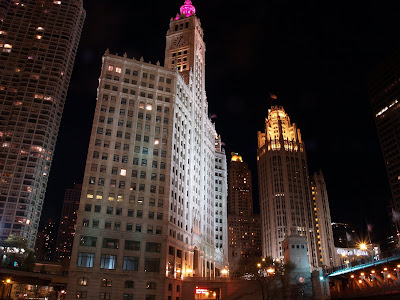North of Chicago Avenue we enter the old residential area of the Gold Coast. On the corner of Dearborn and Chicago sits the most expensive YMCA built at the time.

We continued to walk down Dearborn past such late 19th Century gems like these

Not too far north from this location is Chicago's oldest Park : Washington Square. A place where mid-19th century speakers would get up on they're soapbox. Washington Square Park was founded in 1853 and other than an addition of a fountain in it's center looks much like it did then.


We walked west through the park over Clark Street so our guide could show us a residence that still had the old numbering System. Prior to 1909, the street names and the numbers were a mishmash of things. Street names would change and the numbers apparently were still based at Lake Street. Here's a fine example of a residence on Delaware with both systems.

We turned off of Delaware and continued heading north on La Salle. There was a least four churchs we past that our guide didn't mention and I went back the next day to take shots of these buildings. I'm still doing research about the churchs so that will be a seperate post. We did stop by a an apartment building whose side had to be reduced with the widening of La Salle. See below

The 1960's were a time of urban renewal projects across America and Chicago's Near North Side had two major projects. Cabrini Green was the well known urban project to clear the slums of west of Wells street. Somewhat in it's shadow was a project for the middle-class known as Sandburg Village Sandburg Village was built on land cleared between 1400 North and North Avenue and Between LaSalle and Clark. The site contains both highrises and low-rise townhomes. Despite the intended class of homes the two sites contain, both project's are similar in construction. The exteriors of the highrises at Sandburg Village are only slightly nicer and they include balconies. Something Cabrini-Green lacked. Sandburg Village was built as apartments but during the Condo-craze of the late 1980's and early '90's the complex was converted. With most of Cabrini-Green razed, Sanburg Village remains as one of those mid-twentieth Century ideas of urban renewal.



We left the sterile mid-century Sanburg Village and walked across La Salle to look at some renovations that an artist community made during the period of the 1920's to 1940's. Theophil Studio's was renovated in 1940 and has that very Art Deco feel

We headed back north on La Salle Street and then over to Clark where this impressive mid-century bank stands. The building is all glass and steel much like a mid-century skyscraper. It was built at a time when Chase Manhattan Bank built a glass safe to proof what a great institution they were. I won't argue with this being an interesting bank and it's the only mid-century bank building slated to be added to Chicago's Historical buildings.

This concludes this tour. This was the last tour that Forgotten Chicago was hosting this year. I look forward to what they may produce next year.









































